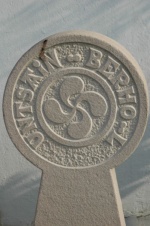Basque Cross and Nkontim Symbol
(The Lauburu)


Stela marker with lauburu
In the Basque Country, the symbol became popular in the 16th century art either as a representation of the four medieval regions (Araba, Biscay, Gipuzkoa and Navarre) or as a Christian Cross (following the Reconquista). The symbol doesn't appear on the Basque Flag or any of the coats-of-arms of the seven regions (Álava, Bizkaia, Guipúzcoa, Navarra, Behe Nafarroa, Lapurdi and Zuberoa).
Nkontim Symbol

A symbol with similar characteristics, though completely unrelated to the Basque Cross, is the African Nkontim. (Coincidentally, however, just as the word lau-buru is associated with mountains, there is a hill in Cameroon called Nkontim.)
The symbol's hairy and industrious image gives a clue to its meaning:
- Nkontim is an Adinkra (West African) symbol meaning 'loyalty and readiness to serve'. (See mycustomstationery.com/...)
- Nkontim in English is 'Hair of the queen's servant'. Not an everyday word, of course, but keeping traditional cultures alive is good for everyone. English and French are the most widely spoken languages in the area.
The symbol can be seen painted on the shells of African drums sold to tourists.

Cross Gurgity
A similar form is seen in other heraldic designs with the generic name Cross Gurgity; from the Latin gurges, meaning 'spiral' or 'whirlpool'.
The form is also referred to as a Circular Fylfot (see Swastika / Suavastika), a Curved Cross and a feature of several others.

